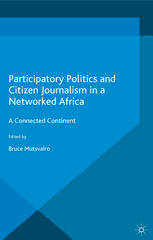
Participatory Politics and Citizen Journalism in a Networked Africa: A Connected Continent PDF
Preview Participatory Politics and Citizen Journalism in a Networked Africa: A Connected Continent
Participatory Politics and Citizen Journalism in a Networked Africa This page intentionally left blank Participatory Politics and Citizen Journalism in a Networked Africa A Connected Continent Editedby Bruce Mutsvairo NorthumbriaUniversity,UK Selection,introductionandeditorialmatter©BruceMutsvairo2016 Foreword©StuartAllan2016 Individualchapters©Respectiveauthors2016 Softcover reprint of the hardcover 1st edition 2016 978-1-137-55449-9 Allrightsreserved.Noreproduction,copyortransmissionofthis publicationmaybemadewithoutwrittenpermission. Noportionofthispublicationmaybereproduced,copiedortransmitted savewithwrittenpermissionorinaccordancewiththeprovisionsofthe Copyright,DesignsandPatentsAct1988,orunderthetermsofanylicence permittinglimitedcopyingissuedbytheCopyrightLicensingAgency, SaffronHouse,6–10KirbyStreet,LondonEC1N8TS. Anypersonwhodoesanyunauthorizedactinrelationtothispublication maybeliabletocriminalprosecutionandcivilclaimsfordamages. Theauthorshaveassertedtheirrightstobeidentifiedastheauthorsofthis workinaccordancewiththeCopyright,DesignsandPatentsAct1988. Firstpublished2016by PALGRAVEMACMILLAN PalgraveMacmillanintheUKisanimprintofMacmillanPublishersLimited, registeredinEngland,companynumber785998,ofHoundmills,Basingstoke, HampshireRG216XS. PalgraveMacmillanintheUSisadivisionofStMartin’sPressLLC, 175FifthAvenue,NewYork,NY10010. PalgraveMacmillanistheglobalacademicimprintoftheabovecompanies andhascompaniesandrepresentativesthroughouttheworld. Palgrave®andMacmillan®areregisteredtrademarksintheUnitedStates, theUnitedKingdom,Europeandothercountries. ISBN 978-1-349-56835-2 ISBN 978-1-137-55450-5 (eBook) DOI 10.1057/9781137554505 Thisbookisprintedonpapersuitableforrecyclingandmadefromfully managedandsustainedforestsources.Logging,pulpingandmanufacturing processesareexpectedtoconformtotheenvironmentalregulationsofthe countryoforigin. AcataloguerecordforthisbookisavailablefromtheBritishLibrary. LibraryofCongressCataloging-in-PublicationData Names:Mutsvairo,Bruce,1979– Title:Participatorypoliticsandcitizenjournalismina networkedAfrica:aconnectedcontinent/editedbyBruce Mutsvairo,NorthumbriaUniversity,UK. Description:Houndmills,Basingstoke,Hampshire;NewYork:Palgrave Macmillan,2016. | Includesbibliographicalreferences. Identifiers:LCCN2015025770 | ISBN9781137554499 Subjects:LCSH:Citizenjournalism—Politicalaspects—Africa. | Online journalism—Politicalaspects—Africa. | Socialmedia—Political aspects—Africa. | Politicalparticipation—Africa. Classification:LCCPN4784.C615P372016 | DDC079/.6—dc23 LCrecordavailableathttp://lccn.loc.gov/2015025770 Contents ListofTablesandFigures vii ForewordbyStuartAllan viii NotesonContributors xii 1 RecapturingCitizenJournalism:ProcessesandPatterns 1 BruceMutsvairo Part I RecapturingProductionPractices 2 NetworkedSocialJournalism:Media,CitizenParticipationand DemocracyinNigeria 19 FarooqA.Kperogi 3 CrossingTabooLines:CitizenJournalismEthicsinPolitical CrisisSettings 34 LastMoyo 4 ThePositioningofCitizen-InfluencedRadiointheBattlefor theControlofMinds 59 EveretteNdlovu 5 WhytheArabSpringNeverCametoEthiopia 77 TerjeSkjerdal 6 CitizenJournalismatCrossroads:MediatedPoliticalAgency andDuressinCentralAfrica 90 MirjamdeBruijn Part II Prospects,PromisesandPitfalls 7 SouthAfricanArabSpringorDemocracytoCome? AnAnalysisofSouthAfricanJournalists’Engagementwith CitizenrythroughTwitter 107 GlendaDaniels 8 DigitalTechnologiesandtheExtractiveSector:TheNewWave ofCitizenJournalisminResource-RichCountries 123 ErikaRodriguesandAnyaSchiffrin 9 Crowdfunding:AHarambeeforAfricanJournalism? 139 KristinSkareOrgeret v vi Contents 10 PoliticsofPassionandthePursuitofPropagandain Zimbabwe’sStateMedia:AStudyoftheCaseofTheHerald 157 BruceMutsvairo 11 BeyondBlindOptimism:TheCaseofCitizenJournalisminthe StruggleforDemocracyinZimbabwe 171 CleophasT.Muneri Part III PerceptionsandCritiques 12 PoliticalParticipation,AlternativeMediaandCitizen JournalisminLusophoneAfrica 187 SusanaSalgado 13 Between“Bottom-Up”JournalismandSocialActivismin UnequalSocieties:TheCaseofGroundUpinSouthAfrica 202 WallaceChuma 14 CitizenJournalismandNationalPoliticsinZimbabwe:The Caseofthe2008and2013Elections 215 JosephMujereandWesleyMwatwara 15 CitizenJournalisminKenyaasaContested“ThirdSpace” 229 GeorgeOgolaandMikeOwuor 16 CitizenJournalismandtheEbolaOutbreakinAfrica 244 WinstonManoandviolac.milton 17 FromCitizenJournalismtoHumanRightsJournalism: FramingtheEbolaEpidemicinSierraLeoneonFacebook 262 IbrahimSeagaShaw Index 279 Tables and Figures Tables 16.1 Selectedheadlinesofnewsstoriesinthedigitaleditionof TheHerald(2014) 249 16.2 SelectedheadlinesontheEbola2014newsstoriesonwww. NewZimbabwe.com 253 16.3 EbolanewsstoriesonMyNews24rankedinorderof “newsworthiness” 255 17.1 BasicbinaryfeaturesofHRJandHWJ 266 17.2 Fact-andcomment-basedposts,andtotalposts 271 17.3 Eliteandgrass-rootsources’postsonFBSLDECFbetween FebruaryandApril2015 273 17.4 PPPF,EAVF,OFandtotalposts 275 Figures 2.1 ThesocialmediafollowingofNigeriannewsmedia 28 6.1 FacebookpostswithYouTubefilmaboutthepolicetortureof studentsafterMarch9protests 96 6.2 Facebookpost,pickinguptheYouTubefilmaboutthepolice tortureofstudentsafterMarch9protests 97 6.3 FacebookpostinreactiontotheYouTubefilmaboutthe policetortureofstudentsafterMarch9protests 98 6.4 PostofY.whileprotesting,andacommentofG.tothispost (11March) 99 6.5 G.’sfirstpost 100 7.1 Publicengagementversusothertweets 112 17.1 Eliteandgrass-rootsources’posts 271 17.2 Fact-vscomment-basedposts 273 17.3 PPPF,EAVFandOF 275 vii Foreword Tracing the twists and turns in the evolution of citizen journalism in our digitalageisaformidablechallenge,notleastbecauseofthedazzlingspeed technologicalimperativesseemtounfoldacrosstheglobe.Still,whenreflect- ingonvariousenquiriesdelvingintohowsuchinnovationshavehelpedto recastwhatcountsasjournalism–andwhocanlayclaimtotheroleofjour- nalist – over the last decade, it is worth recalling contrary instances when thelimitsoftechnology-centredthinkingwerethrownintosharprelief. Back in 2006 I came across one such example when reading a New York TimesnewsstoryaboutAlfredSirleafandhisplywoodshed,TheDailyTalk, in civil war-torn Liberia at the time. “In a country where wheelbarrows fill inforpickuptrucks,wateriscarriedonlittlegirls’headsinsteadofinpipes andgallon-sizejarsreplacegaspumps,”TimesreporterLydiaPolgreen(2006) wrote,“itisperhapsnowonderthatabatteredblackboardservesasnewspa- perandnewsreelallinone.”ThestorydetailedhowSirleafpostednewsand editorialsontheblackboardpositionedonthestreetoutsidehis“newsroom” every day, thereby providing passers-by with important insights into what was happening in Monrovia. Equipped with his “nose for a good scoop”, this“self-taughtnewshound”scoursnewspapers–andcallsonaninformal network of friends acting as correspondents – for the information neces- sary to keep everyone “in the know”. News stories are concisely written in a style relying on street words that people used themselves (“big stealing” rather than “embezzlement”, for example). “I like to write the way people talksotheycanunderstanditwell,”hesaid.“Yougottoreachthecommon man”andwoman.Sirleaf’sdedicationtocitizenreportinghasmetresistance from those in power over the years; he was arrested and spent a brief spell in prison, then went into exile while his news-stand was torn down. Hav- ingrebuiltitbythetimehemetPolgreen,heremainedassteadfastasever in his belief that what he was doing mattered for the country’s emergent democracy. It is precisely this commitment to an alternative ethos of citizen-led reportage that shines brightly through the celebratory hype that so often accompanies discussions of prodigious “technological revolutions” trans- forming the digital mediascape. In 2014, I visited the Kenyan Red Cross and Red Crescent operations compound on the outskirts of Nairobi, where I heard how significant the first-hand reportage of health-care workers was proving to be for those tracking the Ebola crisis in West Africa. Their per- sonal, impromptu accounts, photographs and video clips, shared across blogs and social media sites, were vital sources of news, bearing witness viii Foreword ix to what was actually transpiring on the ground, often with heart-rending poignancy.Meanwhile,criticismsoftheAfricanmedia’scoverageofthecri- sis were growing ever sharper. Eric Chinje (2014), writing in Nairobi’s The Star, pointed out that “coverage of the pandemic has brought to the fore some of the fundamental challenges facing media in Africa and, possibly, aroundtheworld”.Morespecifically,heargued: ReportsontheEbolapandemicarerepletewithimagesofdeathandthe violence of the disease, giving media consumers a real life equivalent of a Hollywood horror movie of alien invaders. [...] Media has not been complicit in some macabre plot to return Africa to the disease narra- tive. Certainly not media in Africa. If anything, media professionals on thecontinenthave,intheircut-and-pasteapproachtocoverage,demon- stratedadebilitatingignoranceoftheissuesandoftheirroleinassisting societydealwiththeimpactofthedisease. (Chinje,2014) ForChinje,thecrucialissuerevolvedaroundwhatheregardedasthefailure of journalists and editors to ask the right questions. Coming to terms with the crisis meant pursuing robust lines of enquiry, such as looking “beyond the frightening body count” to examine coping mechanisms; addressing larger, structural problems of governance, leadership and trust; identifying breakdownsintheuseofforeignaid;recognizing“thehavoconfragilesoci- eties brought about by the unregulated international market for guns and bombs”;andunravellingforscrutinyhowthepharmaceuticalindustryoper- ates in Africa, amongst other exigent issues. As Chinje reminded us, “until therealquestionsareasked,therealstorywillneverbetold”. It is in striving to inspire African journalism to move swiftly beyond “cut-and-paste approaches to coverage” that Bruce Mutsvairo’s edited col- lection Participatory Politics and Citizen Journalism in a Networked Africa: A Connected Continent makes its intervention. Gathered on these pages is a remarkably impressive range of studies exploring how, when and why ordinary individuals are engaging in news-making, and what it means for re-visioning journalism’s future prospects. It opens with Mutsvairo’s intro- duction, “Recapturing Citizen Journalism: Processes and Patterns”, which sets the terms for the ensuing discussion and debate. From there, in Part I, weturntoFarooqA.Kperogi’sexaminationoftheroleofthe“guerrillapress” inarticulatingdissentinNigeriasincethe1990s.LastMoyo’schapterfocuses oncertain“moralpanics”engenderedbyperceivedlapsesincitizenjournal- ism ethics and their implications for African journalism. Short Wave Radio Africa is centred for attention in Everette Ndlovu’s study, which considers how this UK-based diasporic radio station encourages political activism in Zimbabwe. Terje Skjerdal investigates “why the Arab Spring never came to Ethiopia”, offering an effective contrast to triumphant treatments of social
